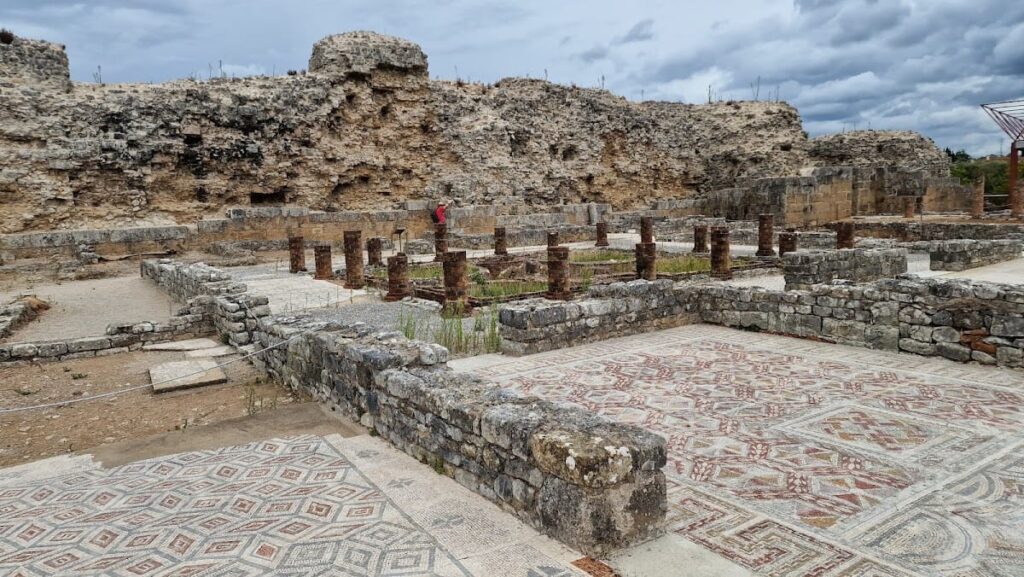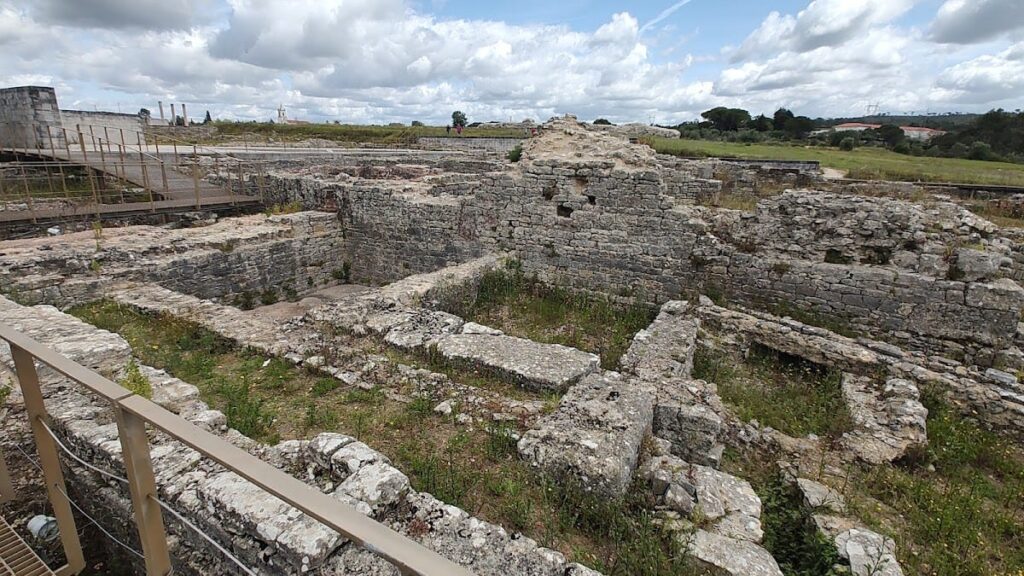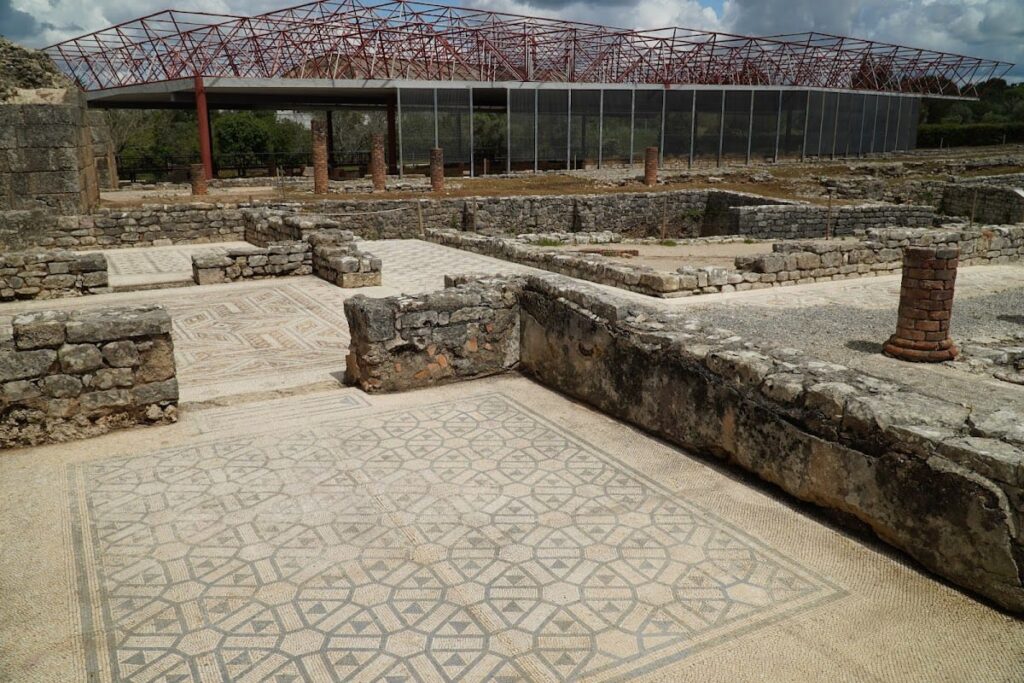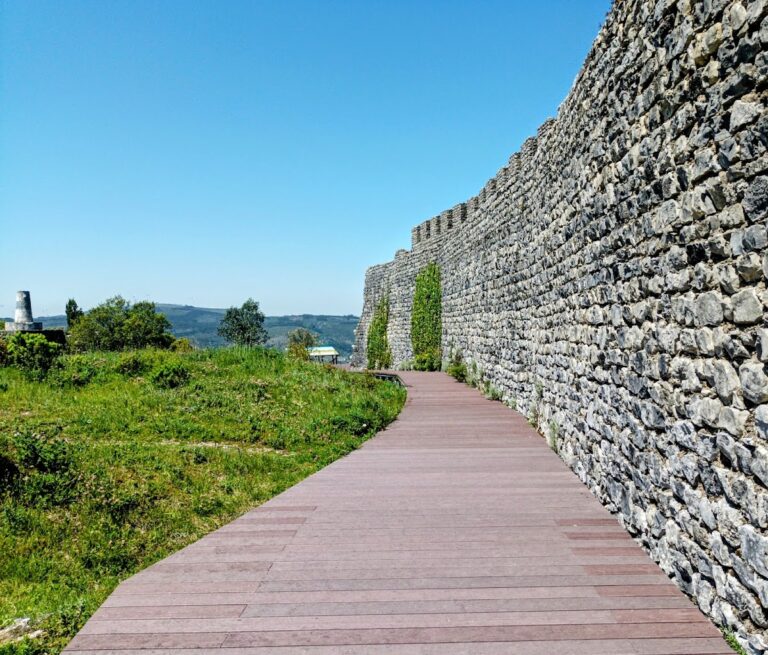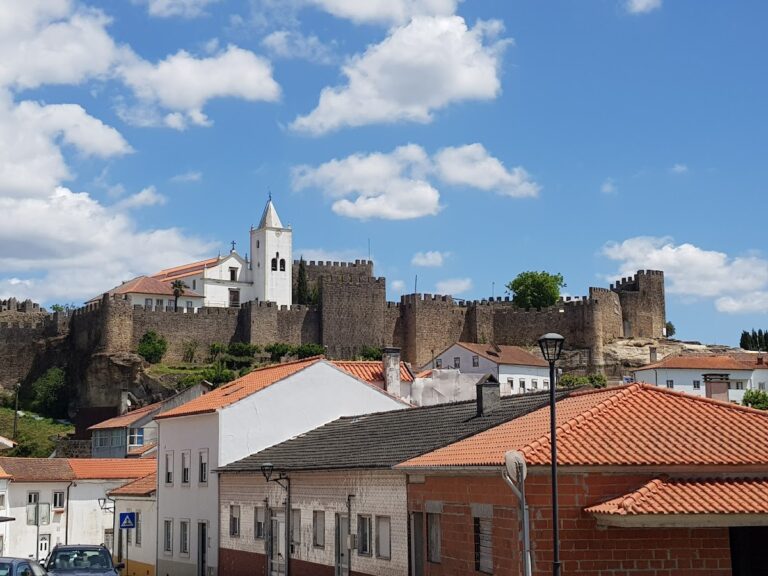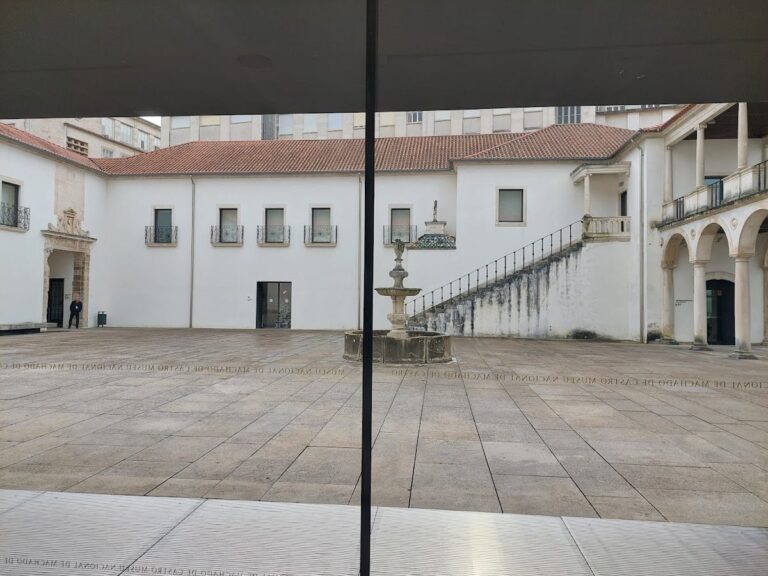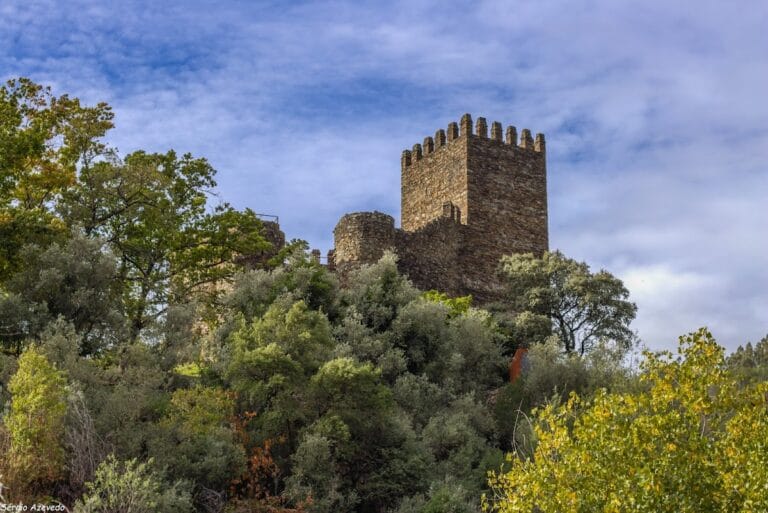Conimbriga: An Ancient Roman Municipium in Central Portugal
Table of Contents
Visitor Information
Google Rating: 4.6
Popularity: Medium
Google Maps: View on Google Maps
Official Website: www.museusemonumentos.pt
Country: Portugal
Civilization: Roman
Remains: City
Context
Conimbriga is located within the municipality of Condeixa-a-Velha in the Coimbra District of central Portugal. The archaeological site occupies a gently inclined triangular plateau overlooking the fertile plains of the Mondego River valley. This elevated position provided natural defensive advantages, bordered notably to the south by the Ribeira dos Mouros stream. The site’s proximity to rich agricultural lands and its situation along ancient terrestrial routes connecting the Atlantic coast with the interior Iberian Peninsula contributed to its regional significance.
Archaeological investigations have established that Conimbriga’s occupation began during the Iron Age, associated with the Castro culture characteristic of northwestern Iberia. The settlement underwent substantial transformation following Roman conquest, particularly from the late Republican period through the early Imperial era, when it was reorganized according to Roman urban planning principles. Material remains demonstrate continuous habitation into Late Antiquity, with evidence of urban contraction and episodes of destruction in the fifth century CE. The causes of decline remain a subject of scholarly discussion, reflecting complex political and military dynamics in the region.
Interest in Conimbriga’s archaeological heritage emerged in the nineteenth century, leading to systematic excavations and artifact recovery. Extensive campaigns throughout the twentieth and twenty-first centuries have revealed well-preserved mosaics, architectural remains, and urban infrastructure. The site is protected under Portuguese heritage legislation and features an on-site museum that presents selected finds and interpretive materials. Ongoing conservation efforts aim to safeguard the remains and facilitate scholarly research.
History
Conimbriga’s historical trajectory encompasses its origins as an indigenous fortified settlement, its development into a prominent Roman municipium, and its eventual decline during the early medieval period. Situated within the Roman province of Lusitania, the site reflects broader regional processes including Roman military conquest, imperial urbanization, Late Antique instability, and the transition to post-Roman political structures. Its strategic location along key land routes and fertile agricultural zones influenced its growth and later abandonment as shifting political and military pressures reshaped settlement patterns in central Portugal.
Iron Age and Pre-Roman Period (c. 9th century BCE – 139 BCE)
Prior to Roman conquest, Conimbriga was a fortified settlement linked to the Castro culture, with continuous occupation from the late Bronze Age through the Iron Age. The toponym combines the indigenous term “conim,” meaning “rocky eminence,” with the Celtic suffix “briga,” denoting “fortress” or “citadel,” reflecting the site’s elevated and defensible position. Archaeological evidence includes polished gray pottery decorated in indigenous styles, bronze sickles, and ornamental pendants, indicating local artisanal traditions. The settlement occupied a plateau-shaped triangular spur bordered by deep ravines, including the Ribeira dos Mouros, which enhanced its natural defenses.
Conimbriga functioned as a regional center connected to wider trade networks, including commercial exchanges with Mediterranean cultures such as the Phoenicians. Imported luxury goods recovered from this period—ivory combs, fibulae, and amphorae—attest to these contacts. This phase of occupation concluded with Roman military campaigns in the region, notably the arrival of Roman forces under Decimus Junius Brutus around 139 BCE during efforts to subdue local tribes such as the Galaeci.
Roman Conquest and Early Urbanization (139 BCE – 1st century CE)
The Roman conquest initiated a period of profound transformation at Conimbriga. Following military subjugation in the late second century BCE, the settlement was reorganized in accordance with Roman urban planning during the reign of Emperor Augustus. The construction of the first Roman forum established a civic and commercial nucleus, comprising a basilica serving judicial functions, a curia for municipal magistrates, and a series of shops. An aqueduct was engineered to channel water from the Alcabideque spring approximately 2.5 kilometers away, facilitating the development of public baths and supporting urban expansion.
Defensive walls approximately 1,500 meters in length were erected, enclosing an area of about 23 hectares. These fortifications integrated the natural topography with Roman masonry techniques, employing squared stone blocks and lime mortar. The city’s location on the Roman road connecting Olisipo (modern Lisbon) to Bracara Augusta (modern Braga) positioned it as a strategic junction within Lusitania, enhancing its administrative and commercial significance.
Imperial Roman Period (1st – 3rd centuries CE)
Between 69 and 79 CE, under Emperor Vespasian, Conimbriga was elevated to municipium status, reflecting its enhanced political and administrative role within the Roman Empire. At its zenith, the city supported an estimated population of approximately 10,600 inhabitants. The presence of an amphitheatre with a capacity for 5,000 spectators indicates organized public entertainment and social activities. Prominent Roman families, including the Lucanus, Murrius, Vitellius, and Aponia, established themselves in Conimbriga, intermarrying with indigenous lineages such as the Turrania, Valeria, Alios, and Maelo, illustrating cultural integration.
Urban development featured the construction and remodeling of large private residences (domus) equipped with advanced amenities such as hypocaust heating systems and private baths, exemplified by the Casa de Cantaber and Casa dos Repuxos. Public infrastructure expanded to include multiple bath complexes, commercial shops, and reinforced aqueducts. The city walls were rebuilt or strengthened at the end of the third century, likely in response to increasing external threats. Residential insulae accommodated middle-class artisans and merchants, reflecting a socially stratified urban community.
Late Antiquity and Suebic Invasions (4th – 5th centuries CE)
During the fourth century, Christianity gained prominence in Conimbriga, as evidenced by the construction of a paleo-Christian basilica within the urban fabric, repurposing an earlier domus. The city walls were reconstructed in a robust but somewhat hastily executed manner, indicative of growing insecurity amid barbarian incursions. Between 465 and 468 CE, the Sueves invaded and sacked Conimbriga, damaging fortifications and enslaving inhabitants, including members of the local aristocracy such as the family of Cantaber.
This violent episode precipitated demographic dispersal, with many residents relocating to the nearby site of Aeminium (modern Coimbra), which offered superior defensive and water supply conditions. Despite this decline, Conimbriga remained inhabited into the sixth century and functioned as the seat of a bishopric under Bishop Lucêncio, who participated in the First and Second Councils of Braga. By 589 CE, the episcopal seat was transferred to Aeminium, marking the cessation of Conimbriga’s ecclesiastical prominence.
Early Medieval Period and Decline (6th – 9th centuries CE)
Following the Visigothic conquest of Lusitania in 586 CE, Conimbriga’s urban and administrative importance diminished markedly. The bishopric and much of the population relocated to Aeminium. Archaeological evidence, including Visigothic coinage and artifacts from the early Muslim period, indicates that the site was not immediately abandoned but experienced gradual decline. Remaining inhabitants established the nearby settlement of Vila Cova, later known as Condeixa-a-Velha, signaling a shift in local habitation patterns.
By the ninth century CE, references to Conimbriga disappear from historical records, indicating its effective abandonment as a major urban center and the end of its civic role in the region.
Modern Rediscovery and Archaeological Research (19th century – present)
Although known since the sixteenth century, systematic archaeological excavations at Conimbriga commenced in 1873 under the auspices of the Instituto de Coimbra. Subsequent large-scale campaigns throughout the twentieth and twenty-first centuries have uncovered extensive remains, including mosaics, public buildings, and the amphitheatre. The site is protected as a National Monument and features an on-site museum presenting artifacts and interpretive materials. Conservation efforts focus on preserving mosaics and structural remains beneath protective coverings. Conimbriga remains the most visited archaeological site in Portugal and is a candidate for UNESCO World Heritage designation, underscoring its enduring cultural and historical significance.
Daily Life and Importance by Period
Roman Conquest and Early Urbanization (139 BCE – 1st century CE)
Following Roman conquest, Conimbriga evolved from an indigenous fortified settlement into a Romanized urban center. The population increasingly comprised Roman settlers alongside local inhabitants, as reflected in the establishment of municipal institutions such as magistracies, likely duumviri, attested by inscriptions. The forum complex functioned as the administrative and commercial heart of the city.
Economic activities centered on agriculture supported by the fertile surrounding plains, supplemented by artisanal production and trade facilitated by Conimbriga’s position on the main Lusitanian road. Workshops producing pottery and metal goods operated at household and small-scale levels. The aqueduct enabled the construction of public baths, enhancing urban amenities and hygiene. Domestic interiors featured mosaic pavements and painted walls, with houses arranged around courtyards. Diet primarily included cereals, olives, and fish, supplemented by imported goods such as wine and oil amphorae available in local markets. Transport relied on footpaths and animal-drawn carts along Roman roads. Religious practice remained largely traditional, with civic life organized around municipal structures.
Imperial Roman Period (1st – 3rd centuries CE)
At its peak as a municipium, Conimbriga’s population exceeded 10,000 inhabitants, comprising Roman settlers, local elites, artisans, merchants, and slaves. Prominent families such as the Lucanus and Murrius integrated with indigenous lineages, illustrating cultural fusion. Social stratification is evident in the urban fabric, with elite domus featuring hypocaust heating, private baths, and elaborate mosaics, while insulae housed artisans and merchants.
Economic activities diversified to include agriculture, textile production, and crafts. Public amenities such as large bath complexes and an amphitheatre hosting 5,000 spectators indicate an active social community with organized leisure. Markets in the forum offered local produce and imported luxury goods, facilitated by Conimbriga’s strategic location. Transportation included carts and pack animals for goods and people. Religious life evolved with the construction of civic temples and shrines, though specific deities remain less documented. Civic governance was conducted by local magistrates and councils, administering justice and public works. The city walls were reinforced in the late third century, reflecting concerns over external threats.
Late Antiquity and Suebic Invasions (4th – 5th centuries CE)
In Late Antiquity, Conimbriga experienced demographic decline and social upheaval amid increasing barbarian pressures. The population remained mixed but diminished, with Christianization evident through the conversion of a domus into a paleo-Christian basilica. Religious practices shifted toward Christianity, with bishops such as Lucêncio playing key roles in regional ecclesiastical councils.
Economic activities contracted but persisted locally, focusing on sustaining the remaining population. Defensive walls were hastily rebuilt, indicating insecurity. The Suevic sack between 465 and 468 CE devastated the city, destroying fortifications and enslaving inhabitants, including aristocratic families. This event triggered population dispersal, with many relocating to Aeminium. Domestic life became more modest; archaeological evidence suggests reduced maintenance of elaborate homes. Markets and trade diminished, and transport likely reverted to basic local routes. Despite decline, Conimbriga retained a bishopric seat until the late sixth century, underscoring its residual religious importance.
Early Medieval Period and Decline (6th – 9th centuries CE)
Following Visigothic conquest, Conimbriga’s urban structure and population contracted further. The episcopal seat moved to Aeminium by 589 CE, reflecting the city’s loss of ecclesiastical and administrative status. Remaining inhabitants lived in smaller, simpler dwellings, with archaeological finds such as Visigothic coins indicating continued, though limited, occupation.
Economic life was localized, with agriculture and artisanal activities supporting a reduced community. The founding of nearby Vila Cova (later Condeixa-a-Velha) suggests a shift in settlement patterns toward more defensible or resource-rich locations. Religious practice adapted to Visigothic Christian traditions, but no major new constructions are documented. Transport and trade networks diminished, focusing on local exchanges. By the ninth century, references to Conimbriga cease, marking its effective abandonment as a major urban center and the end of its civic role in the region.
Remains
Architectural Features
Conimbriga occupies a triangular plateau bordered to the south by the Ribeira dos Mouros. The urban layout developed through three principal phases: the Augustan period (late 1st century BCE to early 1st century CE), the Flavian period (late 1st century CE), and modifications in the 3rd century CE. The city was enclosed by stone walls approximately 1,500 meters in length, forming a roughly triangular perimeter. These walls, primarily dating to the late 3rd century CE, replaced earlier Augustan fortifications and were constructed using large, irregular carved blocks, many repurposed from earlier buildings. Wall heights range from 5 to 6.5 meters and include vaulted entrance gates with two doors, originally defended by towers. Two parallel drainage passages run alongside the walls to channel water away and prevent infiltration.
The city’s streets were paved and aligned according to Roman urban planning principles. Residential areas comprise multi-story apartment blocks (insulae) and private houses (domus) with interior courtyards (peristyles). The urban infrastructure integrated natural terrain features with Roman engineering, including an aqueduct supplying water from the Alcabideque spring approximately 2.5 kilometers distant. The aqueduct and water system were reinforced in the 3rd century CE. After the 5th century, the urban area contracted due to invasions and population shifts.
Key Buildings and Structures
City Walls
The city walls, dating mainly from the late 3rd century CE, are constructed of large, irregular stone blocks, many reused from earlier structures. The walls form a roughly triangular enclosure about 1,500 meters in length, with heights varying between 5 and 6.5 meters. Vaulted entrance structures feature two doors, one hinged, and were originally defended by two towers. Two parallel passages run alongside the walls to prevent water infiltration. The north-south wall segment divides the city into two zones. The walls sustained damage during the Suebic invasions around 468 CE. The construction style suggests urgency, likely due to external threats in the 3rd and 4th centuries CE.
Forum
The original forum was constructed during Augustus’s reign (late 1st century BCE to early 1st century CE) and represents the earliest Roman building phase at Conimbriga. It comprised a crypto-portico (covered walkway), a basilica serving as a tribunal, a council chamber (curia), and commercial shops. The western side contained nine shops for merchants, while the eastern side housed the curia and basilica. Under the Flavian dynasty (late 1st century CE), a larger Imperial forum replaced the earlier Republican forum. This new forum was enclosed by high walls and displayed statues of notable men but ceased to function as a place for justice or commerce. The forum remained in use until the 5th century CE, when a large cistern was installed in part of its area. The forum was part of the urban renewal following Conimbriga’s elevation to municipium status between 69 and 79 CE under Emperor Vespasian.
Temple (within the Forum)
The temple associated with the forum is in poor condition, with only a few stones remaining. Built in the 1st century CE, it was small and designed solely to house divine statues, lacking space for religious ceremonies. The temple connected to the forum square by a small lateral staircase. The forum square was accessed through an arch leading to the temple and a fountain, indicating a cultic area. The temple’s pillars were decorated with fillets dividing them into semicylindrical sections. A portico surrounded the forum square on three sides, with another portico providing access to the temple’s veranda. The specific deity or deities worshipped here remain unidentified due to limited epigraphic evidence.
Casa de Cantaber
The Casa de Cantaber is the largest known private residence excavated at Conimbriga, covering over 3,260 square meters. Constructed in the 1st century CE, likely over earlier structures, it contains approximately 40 rooms. The house features a hypocaust heating system circulating hot air beneath floors and through perforated bricks in walls. The residence includes private baths in its garden, remodeled multiple times. Cantaber, the house’s owner in the 5th century CE, was a local aristocrat murdered during the Suebic invasions; his family was enslaved. The Casa de Cantaber has undergone intermittent archaeological interventions since the late 19th century, with extensive excavations and restorations in the late 20th century.
Casa dos Repuxos
The Casa dos Repuxos is a domus constructed in the 2nd century CE, likely over a pre-existing building. Covering approximately 569 square meters, it is noted for its peristyle garden and sophisticated water features, including channels and fountains. Excavations in the 20th century revealed rich mosaics and decorative elements within the house, reflecting the wealth and status of its occupants.
Bath Complexes
Conimbriga contains three distinct bath complexes within the city walls: the Great Southern Baths, the Baths of the Wall, and the Baths of the Aqueduct. These baths date from the Augustan period (late 1st century BCE to early 1st century CE) and were remodeled in later centuries, including the 3rd century CE. Each complex includes typical Roman features such as three pools (cold, warm, and hot), changing rooms, and a gymnasium. The heating system is notable for its network of stone ducts beneath the floors supplying hot air (hypocaust system). The Great Southern Baths are located near the southern city wall. The baths were supplied with water from the Alcabideque spring via the aqueduct.
Aqueduct and Alcabideque Spring
The aqueduct supplying Conimbriga was constructed to bring water from the Alcabideque spring, situated approximately 2.5 kilometers from the city. This engineering work supported the urban water needs, particularly for the bath complexes. The aqueduct and associated water infrastructure were reinforced during the 3rd century CE amid increasing external threats.
Amphitheatre
The amphitheatre dates from the end of the Julio-Claudian dynasty (mid-1st century CE). It is located north of the city, utilizing a natural depression in the terrain. The arena is oval, measuring approximately 90 by 60 by 20 meters, and lies about 4 meters below ground level. The amphitheatre featured six entry tunnels, three on each side, and had an estimated seating capacity of 5,000 spectators. Part of the structure was discovered beneath modern homes in Condeixa-a-Nova. Excavations began in 2012–2013 following its identification in 1993. Some rural homes were constructed incorporating parts of the amphitheatre’s structure.
Paleo-Christian Basilica
The paleo-Christian basilica dates from the 5th to 6th centuries CE and was constructed during the Suebic occupation by reusing and transforming an existing domus. It served as the episcopal seat of Conimbriga between 561 and 589 CE. The basilica provides archaeological evidence of continued occupation and Christian worship after the Roman period. It fell out of use when the episcopal seat was transferred to Aeminium (modern Coimbra).
Roads and Urban Layout
The city’s streets were paved and aligned according to Roman urbanism. The urban plan evolved through three main phases: Augustan, Flavian, and 3rd-century modifications including new walls. The city included insulae (multi-story houses with interior patios) and domus with peristyles. Conimbriga was connected by the Roman road (via romana XVI) linking Olisipo (Lisbon) to Bracara Augusta (Braga) via Aeminium (Coimbra).
Other Domestic Buildings
Additional notable residential buildings include the Casa da Cruz Suástica and Casa dos Esqueletos, though less detailed information is available. Many houses featured mosaics, sculptures, and painted murals as decorative elements, reflecting the artistic tastes and social status of their inhabitants.
Other Remains
Surface traces and architectural fragments indicate the presence of other large public structures, though their exact reconstruction remains uncertain due to successive building phases. Remains of commercial shops were found near the forum, confirming a commercial area with nine shops on the western side. Some rural homes were built over or incorporated parts of Roman structures, including sections of the amphitheatre.
Archaeological Discoveries
Excavations at Conimbriga have yielded numerous artifacts spanning from the Iron Age through Late Antiquity. Pottery includes decorated indigenous ceramics from the pre-Roman period and Roman tableware and amphorae. Inscriptions found in the forum and public buildings include dedicatory formulas and official texts. Coins from various periods, including Roman imperial and Visigothic issues, have been recovered. Tools related to agriculture, crafts, and surgery have been found, reflecting diverse economic activities. Domestic objects such as lamps, cooking vessels, and furniture fragments appear in residential contexts. Religious artifacts include statuettes and altars associated with the forum temple and the paleo-Christian basilica. Many finds were locally produced, while some luxury items and imported goods indicate trade connections with Mediterranean cultures.
Preservation and Current Status
The city walls remain largely visible, though some sections are fragmentary or damaged, particularly from the Suebic invasions. The forum and its associated structures survive in partial form, with some walls and foundations preserved. The Casa de Cantaber and Casa dos Repuxos have been extensively excavated and partially restored, including mosaic floors and hypocaust systems. The bath complexes retain structural elements such as pools and heating ducts. The aqueduct’s remains are visible in parts of the water channel. The amphitheatre is partially excavated, with some areas beneath modern buildings. The paleo-Christian basilica is preserved in fragmentary form. Conservation efforts include protective covers over mosaics and structural consolidation. Excavations and restorations have been ongoing since the 19th century, with major campaigns in the 20th and 21st centuries. The site is protected under Portuguese heritage law as a National Monument.
Unexcavated Areas
Several parts of Conimbriga remain unexcavated or poorly studied. Surface surveys and geophysical investigations suggest buried remains in peripheral zones and beneath modern constructions, especially around the amphitheatre and residential districts. Urban expansion in nearby Condeixa-a-Nova has limited excavation in some areas. Future archaeological work is planned but constrained by conservation policies and modern development. Some large public structures indicated by surface traces await detailed investigation.

